Beauty and the Beast Trivia
There is so much interesting trivia about Beauty and the Beast! I will try to include every bit of information on trivia as I can! If you would like to submit any trivia, please use the submission form.
 Beauty and the Beast was nationally Released November 23, 1991 [this film was released on the same day as An American Tail: Fievel Goes West] and cost $30 million to produce. In the first 42 weeks of its U.S. release, this film grossed $144.725 million, and sold 1 million copies of the video nationwide by the end of its first day of release (10/30/92). It took more than 600 animators, artists, and technicians three and a half years to complete the project. [On the same information sheet, it is written that 370 men and women were involved in the film's production of whom 43 were animators, however I believe it is the 600 that is accurate.] BEAUTY is the first animated Disney feature scripted by a woman: Linda Woolverton. The film marked the first time each animator was credited on screen specifically for the character he or she brought to life. In 2002 the United States Library of Congress deemed the film "culturally significant" and selected it for preservation in the National Film Registry. This film inspired a Broadway stage musical which earned tremendous commercial success on its own right and multiple Tony Awards, and became the first of a whole line of Disney stage productions.
Beauty and the Beast was nationally Released November 23, 1991 [this film was released on the same day as An American Tail: Fievel Goes West] and cost $30 million to produce. In the first 42 weeks of its U.S. release, this film grossed $144.725 million, and sold 1 million copies of the video nationwide by the end of its first day of release (10/30/92). It took more than 600 animators, artists, and technicians three and a half years to complete the project. [On the same information sheet, it is written that 370 men and women were involved in the film's production of whom 43 were animators, however I believe it is the 600 that is accurate.] BEAUTY is the first animated Disney feature scripted by a woman: Linda Woolverton. The film marked the first time each animator was credited on screen specifically for the character he or she brought to life. In 2002 the United States Library of Congress deemed the film "culturally significant" and selected it for preservation in the National Film Registry. This film inspired a Broadway stage musical which earned tremendous commercial success on its own right and multiple Tony Awards, and became the first of a whole line of Disney stage productions.

 "Be Our Guest" was originally animated with Maurice (not Belle) as the guest, but they decided not to waste such a wonderful song on a secondary character.
"Be Our Guest" was originally animated with Maurice (not Belle) as the guest, but they decided not to waste such a wonderful song on a secondary character.

 "Chip" originally had only one line, but the producers liked the voice so much that they had extra lines written.
"Chip" originally had only one line, but the producers liked the voice so much that they had extra lines written.

 Tiny Toon Adventure script writer Sheri Stoner was used as the model for Belle. She was also used as the model for Ariel in The Little Mermaid (1989).
Tiny Toon Adventure script writer Sheri Stoner was used as the model for Belle. She was also used as the model for Ariel in The Little Mermaid (1989). 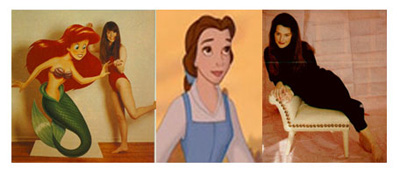
 The second Disney animated feature to use their proprietary CAPS (Computer Assisted Production System) system, a digital ink, paint, and camera process. The Rescuers Down Under (1990) was the first Disney film to use the system. Beauty and the Beast was the first Disney Animated Feature to be painted using the computerized CAPS system. Disney's animation department won a Scientific and Technical Academy Award for the design and development of the Computer Animated Production System used to make the film. This was also the first Disney animated feature to use fully rendered and textured 3-D CGI moving backgrounds in combination with the traditionally animated character animation, a technique that was expanded upon in the Disney short Off His Rockers (1992) and later in Aladdin (1992).
The second Disney animated feature to use their proprietary CAPS (Computer Assisted Production System) system, a digital ink, paint, and camera process. The Rescuers Down Under (1990) was the first Disney film to use the system. Beauty and the Beast was the first Disney Animated Feature to be painted using the computerized CAPS system. Disney's animation department won a Scientific and Technical Academy Award for the design and development of the Computer Animated Production System used to make the film. This was also the first Disney animated feature to use fully rendered and textured 3-D CGI moving backgrounds in combination with the traditionally animated character animation, a technique that was expanded upon in the Disney short Off His Rockers (1992) and later in Aladdin (1992). 
 The signs that Maurice encounters in the forest show the names of California cities: one points to "Anaheim", while the other points down a dark and sinister-looking path to "Valencia". Anaheim is the location of Disneyland, while the rival Six Flags Magic Mountain amusement park is in Valencia.
The signs that Maurice encounters in the forest show the names of California cities: one points to "Anaheim", while the other points down a dark and sinister-looking path to "Valencia". Anaheim is the location of Disneyland, while the rival Six Flags Magic Mountain amusement park is in Valencia.
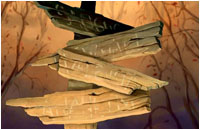
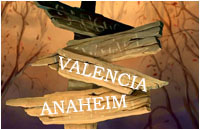
 The last phrase of Cogsworth's line "Flowers, chocolates, promises you don't intend to keep..." was ad-libbed by David Ogden Stiers.
The last phrase of Cogsworth's line "Flowers, chocolates, promises you don't intend to keep..." was ad-libbed by David Ogden Stiers.
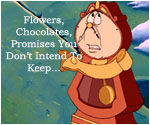
 The original "cute" character of the movie was a music box, which was supposed to be a musical version of Dopey. But when the character Chip's role was expanded, the music box idea was scrapped. However the music box can be seen for a brief moment on a table next to Lumière just before the fight between the enchanted objects and the villagers in the Beast's castle.
The original "cute" character of the movie was a music box, which was supposed to be a musical version of Dopey. But when the character Chip's role was expanded, the music box idea was scrapped. However the music box can be seen for a brief moment on a table next to Lumière just before the fight between the enchanted objects and the villagers in the Beast's castle.


 Beauty and the Beast is the first and only full length animated feature to be nominated for an Oscar for Best Picture, losing to The Silence of the Lambs (1991). It was, however, the first full length animated feature to win the Golden Globe for Best Picture (Musical or Comedy). The only other animated films to win this honor were The Lion King and Toy Story 2.
Beauty and the Beast is the first and only full length animated feature to be nominated for an Oscar for Best Picture, losing to The Silence of the Lambs (1991). It was, however, the first full length animated feature to win the Golden Globe for Best Picture (Musical or Comedy). The only other animated films to win this honor were The Lion King and Toy Story 2.
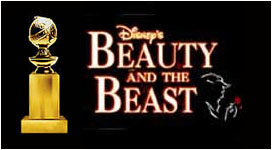
 A song sung by the enchanted objects entitled "Human Again" was cut before production started. The song was later added to the Disney on Ice and theatrical productions and was recorded and animated for the 2001 Imax re-release. It was also added to the special edition released in October 8th 2002, making the movie a bit longer.
A song sung by the enchanted objects entitled "Human Again" was cut before production started. The song was later added to the Disney on Ice and theatrical productions and was recorded and animated for the 2001 Imax re-release. It was also added to the special edition released in October 8th 2002, making the movie a bit longer.
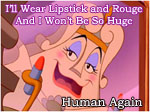
 Art director Brian McEntee color keyed Belle so that she is the only person in her town who wears blue. This is symbolic of how different she is from everyone else around. Later, she encounters the Beast, another misfit, also wearing blue.
Art director Brian McEntee color keyed Belle so that she is the only person in her town who wears blue. This is symbolic of how different she is from everyone else around. Later, she encounters the Beast, another misfit, also wearing blue.
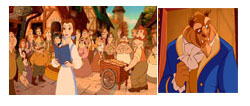
 While songwriters are writing the melody to a song they often use dummy lyrics to help with writing the melody. In the song "Gaston" the writers liked the dummy lyrics so much that they used those in the final production.
While songwriters are writing the melody to a song they often use dummy lyrics to help with writing the melody. In the song "Gaston" the writers liked the dummy lyrics so much that they used those in the final production.
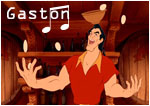
 Computer technology was considered for the rooftop fight and the forest chase, but the primitive state of the technology only allowed time to use it for the ballroom scene. Even for that scene, they had a fallback strategy: what they called the "Ice Capades" version, with just a spotlight on the two characters against a black background.
Computer technology was considered for the rooftop fight and the forest chase, but the primitive state of the technology only allowed time to use it for the ballroom scene. Even for that scene, they had a fallback strategy: what they called the "Ice Capades" version, with just a spotlight on the two characters against a black background.

 In the French release, Cogsworth's name is Big Ben, after the famous clock in London (extra, completely irrelevant, detail for trivia fans: the landmark's real name is "The Clock Tower of the New Palace of Westminster", while Big Ben is actually the name of the large bell that strikes the hours - nevertheless, the clock is seldom referred to by any name other than Big Ben).
In the French release, Cogsworth's name is Big Ben, after the famous clock in London (extra, completely irrelevant, detail for trivia fans: the landmark's real name is "The Clock Tower of the New Palace of Westminster", while Big Ben is actually the name of the large bell that strikes the hours - nevertheless, the clock is seldom referred to by any name other than Big Ben).

 The Beast/Prince's real name is never mentioned. Fans have used several names for the Beast, including Adam, Ruskin d'Auvergnon, Vincent, and others. But in actuality his name is Beast.
The Beast/Prince's real name is never mentioned. Fans have used several names for the Beast, including Adam, Ruskin d'Auvergnon, Vincent, and others. But in actuality his name is Beast.

 When Beast and Gaston are having their life-or-death struggle on the castle, Gaston yells, "Belle is mine!" Originally he was supposed to say, "Time to die!" but the writer changed it to fit Belle back in the scene.
When Beast and Gaston are having their life-or-death struggle on the castle, Gaston yells, "Belle is mine!" Originally he was supposed to say, "Time to die!" but the writer changed it to fit Belle back in the scene.

 Chip is the only object in the movie to mention Belle by her name. All of the other objects refer to her as "mademoiselle", "she", "her", "the girl," etc.
Chip is the only object in the movie to mention Belle by her name. All of the other objects refer to her as "mademoiselle", "she", "her", "the girl," etc.

 This was the first Disney animated movie to use a fully developed script prior to animation. In previous films, story was developed through the use of storyboards only, and was further developed during animation. Several previous films had gone way over budget when the animators spent time and effort animating scenes that, it was eventually decided, did not fit the movie, and producers realized that they could save money by having a script written first.
This was the first Disney animated movie to use a fully developed script prior to animation. In previous films, story was developed through the use of storyboards only, and was further developed during animation. Several previous films had gone way over budget when the animators spent time and effort animating scenes that, it was eventually decided, did not fit the movie, and producers realized that they could save money by having a script written first.
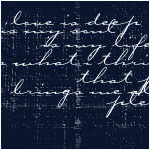
 The dance between Belle and her Prince in the finale is actually reused animation of the dance between Princess Aurora and Prince Phillip in Sleeping Beauty (1959). The original Sleeping Beauty (1959) pair had been drawn over to become the new Beauty and the Beast (1991) pair, and this was done because they were running out of time during the production of the movie.
The dance between Belle and her Prince in the finale is actually reused animation of the dance between Princess Aurora and Prince Phillip in Sleeping Beauty (1959). The original Sleeping Beauty (1959) pair had been drawn over to become the new Beauty and the Beast (1991) pair, and this was done because they were running out of time during the production of the movie. [You can tell by the hair on Belle's Prince; it matches Prince Phillip's hair, except more hair was added because Belle's Prince has longer hair.]

 When Gaston is falling at the very end, there is close-up of his eyes. For a few frames a tiny skull flashes in each of his eyes.
When Gaston is falling at the very end, there is close-up of his eyes. For a few frames a tiny skull flashes in each of his eyes.
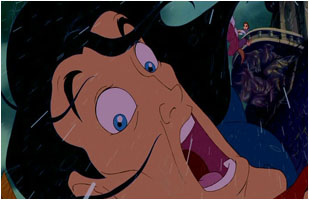

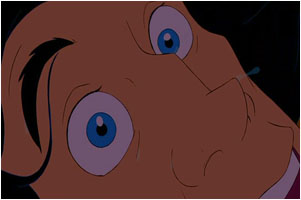
 In the 1930s and again in the 1950s, Walt Disney attempted to adapt "Beauty and the Beast" into a feature but could not come up with a suitable treatment, so the project was shelved. It wasn't until The Little Mermaid (1989) became hugely successful that they decided to try it a third time.
In the 1930s and again in the 1950s, Walt Disney attempted to adapt "Beauty and the Beast" into a feature but could not come up with a suitable treatment, so the project was shelved. It wasn't until The Little Mermaid (1989) became hugely successful that they decided to try it a third time.
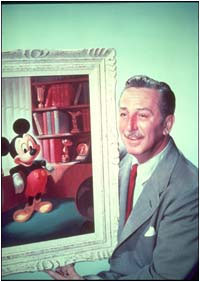
 Angela Lansbury, the voice of Mrs. Potts, thought that another character would be better suited to sing the ballad "Beauty and the Beast". The director asked her to make at least one recording to have for a back up if nothing else worked, and that one recording ended up in the film.
Angela Lansbury, the voice of Mrs. Potts, thought that another character would be better suited to sing the ballad "Beauty and the Beast". The director asked her to make at least one recording to have for a back up if nothing else worked, and that one recording ended up in the film.
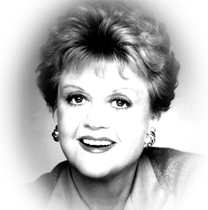

 The film was previewed at the New York Film Festival in September 1991 in a "Work-In-Progress" format. Approximately 70% of the footage was the final color animation. The other 30% consisted of storyboard reels, rough animation pencil tests, clean-up (final line) animation pencil tests, and computer animation tests of the ballroom sequence. This marked the first time that Disney had done a large-scale preview of an unfinished film.
The film was previewed at the New York Film Festival in September 1991 in a "Work-In-Progress" format. Approximately 70% of the footage was the final color animation. The other 30% consisted of storyboard reels, rough animation pencil tests, clean-up (final line) animation pencil tests, and computer animation tests of the ballroom sequence. This marked the first time that Disney had done a large-scale preview of an unfinished film.

 Among the trophy heads on Gaston's tavern is what appears to be a frog's head, visible in the scene where Gaston spits.
Among the trophy heads on Gaston's tavern is what appears to be a frog's head, visible in the scene where Gaston spits. [From the Screen Captures I took, it appears to me that it is some type of lizard or snake.]
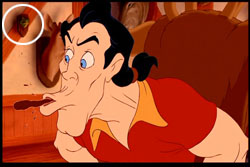
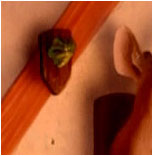
 When The Beast is getting his hair cut for Belle, the hair style he is given is the same as Lion's in The Wizard of Oz (1939).
When The Beast is getting his hair cut for Belle, the hair style he is given is the same as Lion's in The Wizard of Oz (1939).

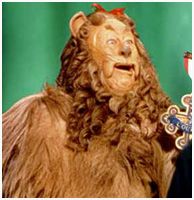
 The smoke seen during the transformation of the Beast to the Prince is actually real smoke, not animated. It was originally used in The Black Cauldron (1985) and was re-used for Beauty and the Beast (1991).
The smoke seen during the transformation of the Beast to the Prince is actually real smoke, not animated. It was originally used in The Black Cauldron (1985) and was re-used for Beauty and the Beast (1991).

 Linda Woolverton drew her inspiration for the screenplay, not from Jean Cocteau's Belle et la bête, La (1946), but from Little Women (1933), admitting that there's a lot of Katharine Hepburn in the characterization of Belle.
Linda Woolverton drew her inspiration for the screenplay, not from Jean Cocteau's Belle et la bête, La (1946), but from Little Women (1933), admitting that there's a lot of Katharine Hepburn in the characterization of Belle. [Below is an image of Katharine Hepburn. She is standing infront of a door, and it reminds me of when Belle leans on the door after Beast tells her, "You will join me for dinner. That's not a request!" There are also two images of Katharine Hepburn from Little Women.]

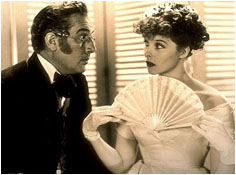

 It was lyricist Howard Ashman who came up with the idea of turning the enchanted objects into living creatures with unique personalities. [Howard Ashman - Left ; Alan Menken - Right]
It was lyricist Howard Ashman who came up with the idea of turning the enchanted objects into living creatures with unique personalities. [Howard Ashman - Left ; Alan Menken - Right]

 Glen Keane, the supervising animator on the Beast, created his own hybrid beast by combining the mane of a lion, the beard and head structure of a buffalo, the tusks and nose bridge of a wild boar, the heavily muscled brow of a gorilla, the legs and tail of a wolf, and the big and bulky body of a bear.
Glen Keane, the supervising animator on the Beast, created his own hybrid beast by combining the mane of a lion, the beard and head structure of a buffalo, the tusks and nose bridge of a wild boar, the heavily muscled brow of a gorilla, the legs and tail of a wolf, and the big and bulky body of a bear.

 You can hear the WILHELM SCREAM: during the raid on the castle, when a villager is thrown through the front doors. The Wilhelm scream is a stock sound effect first used in 1951 for the movie Distant Drums. It has been featured in dozens of movies since. Alongside a certain recording of the cry of the Red-tailed Hawk, the "Universal telephone ring" and "castle thunder," it is probably the most well-known cinematic sound cliché. For more information on the Wilhelm Scream, please visit Wikipedia's Wilhelm Scream Page. Below is the Castle scene where the scream is most possibly heard. To listen to the Wilhelm Scream, please click on the musical note. The sound is in .wav format and should open up in Media Player.
You can hear the WILHELM SCREAM: during the raid on the castle, when a villager is thrown through the front doors. The Wilhelm scream is a stock sound effect first used in 1951 for the movie Distant Drums. It has been featured in dozens of movies since. Alongside a certain recording of the cry of the Red-tailed Hawk, the "Universal telephone ring" and "castle thunder," it is probably the most well-known cinematic sound cliché. For more information on the Wilhelm Scream, please visit Wikipedia's Wilhelm Scream Page. Below is the Castle scene where the scream is most possibly heard. To listen to the Wilhelm Scream, please click on the musical note. The sound is in .wav format and should open up in Media Player. [I will try to locate the sound in the movie and place the exact image that corresponds with the sound. On a personal note, I find the sound to be a bit chilly, perhaps because it plays so quickly.]


 Songs take up twenty-five minutes of the film and only five minutes were without any musical score at all.
Songs take up twenty-five minutes of the film and only five minutes were without any musical score at all.

 Caricatures of the directors, Kirk Wise and Gary Trousdale, can be seen in the scene where Belle is given the book as a gift. As she is leaving the store three men are seen pretending to not look through the window and then they sing, "Look there she goes. The girl who's so peculiar. I wonder if she's feeling well." They are the two men on the outside of the large blonde man.
Caricatures of the directors, Kirk Wise and Gary Trousdale, can be seen in the scene where Belle is given the book as a gift. As she is leaving the store three men are seen pretending to not look through the window and then they sing, "Look there she goes. The girl who's so peculiar. I wonder if she's feeling well." They are the two men on the outside of the large blonde man.
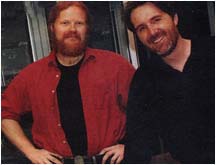
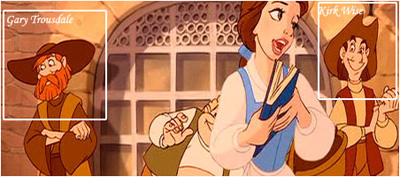
 Robby Benson's voice was altered by the growls of real panthers and lions so that it is virtually unrecognizable. This is why near the end when the Beast transforms into the prince his voice changes. His voice is also not changed on the original motion picture soundtrack.
Robby Benson's voice was altered by the growls of real panthers and lions so that it is virtually unrecognizable. This is why near the end when the Beast transforms into the prince his voice changes. His voice is also not changed on the original motion picture soundtrack.

 This was the first Disney animated feature to have a pop version of the film's main song play over the end credits. [Angela Lansbury, who voiced Mrs. Potts, also recorded a version of the song Beauty and the Beast. This version was used during the actual film when Belle and the Beast dance. Celine Dion and Peabo Bryson's duet is played during the credits. However, at the Academy Awards, all three performed live on stage.]
This was the first Disney animated feature to have a pop version of the film's main song play over the end credits. [Angela Lansbury, who voiced Mrs. Potts, also recorded a version of the song Beauty and the Beast. This version was used during the actual film when Belle and the Beast dance. Celine Dion and Peabo Bryson's duet is played during the credits. However, at the Academy Awards, all three performed live on stage.]
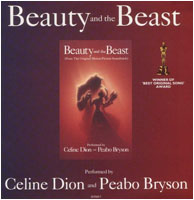
 In "The Mob Song", Gaston quotes Macbeth by William Shakespeare. "Screw your courage to the sticking place." (I, vii) Lady Macbeth's speech to Macbeth to tell him to kill Duncan.
In "The Mob Song", Gaston quotes Macbeth by William Shakespeare. "Screw your courage to the sticking place." (I, vii) Lady Macbeth's speech to Macbeth to tell him to kill Duncan.

 As with all of Disney's other films, the film has been translated into several different languages, the most notable being the French and Japanese versions. Only the French version, however, was included onto the DVD. A clip of the Japanese version can be seen on the Mulan special edition DVD, however.
As with all of Disney's other films, the film has been translated into several different languages, the most notable being the French and Japanese versions. Only the French version, however, was included onto the DVD. A clip of the Japanese version can be seen on the Mulan special edition DVD, however.

 Belle's designers also based some of her appearance and attributes on earlier movie heroines. Belle's peasant dress was loosely based on Judy Garland's (Dorothy) attire from The Wizard of Oz 1939. Additionally, Belle was also inspired by Julie Andrews from The Sound of Music (1965). The scene where Belle runs to the hills singing ("Belle Reprise") is an homage to the opening scene of The Sound of Music.
Belle's designers also based some of her appearance and attributes on earlier movie heroines. Belle's peasant dress was loosely based on Judy Garland's (Dorothy) attire from The Wizard of Oz 1939. Additionally, Belle was also inspired by Julie Andrews from The Sound of Music (1965). The scene where Belle runs to the hills singing ("Belle Reprise") is an homage to the opening scene of The Sound of Music.
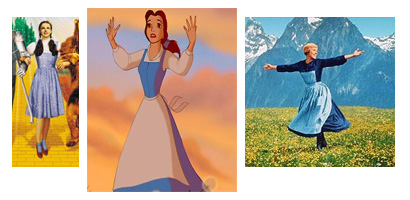
 Gaston is one among few characters in modern Disney films to make chauvinistic comments about women. He calls Belle his "little wife", says that they will have six or seven "strapping boys" like himself and also says that it is inappropriate for women to read books.
Gaston is one among few characters in modern Disney films to make chauvinistic comments about women. He calls Belle his "little wife", says that they will have six or seven "strapping boys" like himself and also says that it is inappropriate for women to read books. Actually this is quite true I believe; there aren't many Disney characters that make these types of remarks about women.

 Beauty and the Beast is the last Disney movie where the entire main cast perform both their speaking parts and their singing parts.
Beauty and the Beast is the last Disney movie where the entire main cast perform both their speaking parts and their singing parts.

 In the video game Kingdom Hearts, its sequels Kingdom Hearts: Chain of Memories, and Kingdom Hearts II, Belle is one of the seven Princesses of Heart central to the game's plot. She is kidnapped when their world is destroyed by the Heartless, and the Beast, through sheer strength of will, follows her to Hollow Bastion, where Sora helps him defeat Maleficent and rescue Belle. In KH2, his world has been restored, but Xaldin, a member of Organization XIII, is manipulating Beast into forsaking Belle and his servants, in an attempt to turn him into a Heartless, so they can recruit the resulting Nobody that forms. All the voice actors for included characters reprise their roles with the exception of the late Jerry Orbach, who is replaced by Jeff Bennett as Lumiere.
In the video game Kingdom Hearts, its sequels Kingdom Hearts: Chain of Memories, and Kingdom Hearts II, Belle is one of the seven Princesses of Heart central to the game's plot. She is kidnapped when their world is destroyed by the Heartless, and the Beast, through sheer strength of will, follows her to Hollow Bastion, where Sora helps him defeat Maleficent and rescue Belle. In KH2, his world has been restored, but Xaldin, a member of Organization XIII, is manipulating Beast into forsaking Belle and his servants, in an attempt to turn him into a Heartless, so they can recruit the resulting Nobody that forms. All the voice actors for included characters reprise their roles with the exception of the late Jerry Orbach, who is replaced by Jeff Bennett as Lumiere.

 The beginning portion of the song “Transformation†in the American original soundtrack, up to the point where magical stardusts begin to fall down from the sky, differs from the actual music used in the film, while foreign versions, including Korean, Japanese and French, match the actual film.
The beginning portion of the song “Transformation†in the American original soundtrack, up to the point where magical stardusts begin to fall down from the sky, differs from the actual music used in the film, while foreign versions, including Korean, Japanese and French, match the actual film. Rather Ironic, No?
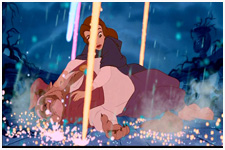
 Tony Jay, who voiced Monsieur D'Arque, played Paracelsus in the Beauty and the Beast tv series, which originally broadcast in 1987 and aired until 1989, and centered around the relationship between Catherine (Linda Hamilton), an attorney who lived in New York City, and Vincent (Ron Perlman), a gentle, but lion-faced "beast" who belongs to a society of misfits and outcasts dwelling in the tunnels beneath the city. Paracelsus was the evil outcast of 'TheWorld Below.'
Tony Jay, who voiced Monsieur D'Arque, played Paracelsus in the Beauty and the Beast tv series, which originally broadcast in 1987 and aired until 1989, and centered around the relationship between Catherine (Linda Hamilton), an attorney who lived in New York City, and Vincent (Ron Perlman), a gentle, but lion-faced "beast" who belongs to a society of misfits and outcasts dwelling in the tunnels beneath the city. Paracelsus was the evil outcast of 'TheWorld Below.'
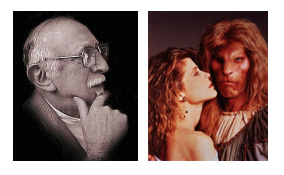
 Submitted by Silicon Hero: In the balcony scene immediately after the magnificent ballroom dance, you can see for a very brief moment, a shooting star in the upper left region. It happens very shortly after Chip gazes up.
Submitted by Silicon Hero: In the balcony scene immediately after the magnificent ballroom dance, you can see for a very brief moment, a shooting star in the upper left region. It happens very shortly after Chip gazes up.
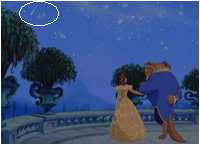
 Submitted by Nyxity: Beauty and the Beast, on April 19, 1994, was the first Disney film to be adapted into a Broadway musical.
Submitted by Nyxity: Beauty and the Beast, on April 19, 1994, was the first Disney film to be adapted into a Broadway musical.
 Submitted by Nyxity: Glene Keane's father is famous as well. He is the cartoonist Bil Keane, creator of "The Family Circus."
Submitted by Nyxity: Glene Keane's father is famous as well. He is the cartoonist Bil Keane, creator of "The Family Circus."
 Submitted by Nyxity: The Beast/Prince's real name is never mentioned. The Disney website he is only addressed as Prince or Beast in the movie and anywhere else. The animators even admit in the commentary on the special edition release that they realized near the end of producing the movie, they hadn't named him. It is rumored that the "Official Encyclopedia of Disney" by Dave Smith says that the Beast's name is "Adam". This is false. What truly tells this is a game produced by Disney Interactive called "The D Show" that came out in 2000. This still gives speculation to whether it was a name simply chosen years later, originated by fans and became popular and so forth.
Submitted by Nyxity: The Beast/Prince's real name is never mentioned. The Disney website he is only addressed as Prince or Beast in the movie and anywhere else. The animators even admit in the commentary on the special edition release that they realized near the end of producing the movie, they hadn't named him. It is rumored that the "Official Encyclopedia of Disney" by Dave Smith says that the Beast's name is "Adam". This is false. What truly tells this is a game produced by Disney Interactive called "The D Show" that came out in 2000. This still gives speculation to whether it was a name simply chosen years later, originated by fans and became popular and so forth.
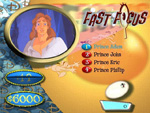
 Submitted by Nyxity: In "The Great Movie Musical Trivia Book" by Jeff Kurtti tells that while Chip was given a bigger role and did take the place of a music box, he also stole the last line of the movie. As quoted,
"Originally, Belle looked quizzically at her newly-handsome prince, squinted and wrinkled her nose and asked, 'Do you think you could grow a beard?'"
Submitted by Nyxity: In "The Great Movie Musical Trivia Book" by Jeff Kurtti tells that while Chip was given a bigger role and did take the place of a music box, he also stole the last line of the movie. As quoted,
"Originally, Belle looked quizzically at her newly-handsome prince, squinted and wrinkled her nose and asked, 'Do you think you could grow a beard?'"
 Submitted by Nyxity: Also in the book the road sign reads "Newhall," "Valencia," and "Aneheim." As quoted,
"Newhall is located in the Santa Clarita Valley, about thirty minutes north of Disney Studios. It is a small town adjacent to: Valencia, the site of the California Institute of the Arts, the multi-disciplinary arts college founded by Walt Disney. Many of the artist and animators associated with Beauty and the Beast attended CalArts.
Anaheim is, of course, the former orange grove about thirty miles south of the Disney Studios, where Disneyland was built in 1954-55."
Submitted by Nyxity: Also in the book the road sign reads "Newhall," "Valencia," and "Aneheim." As quoted,
"Newhall is located in the Santa Clarita Valley, about thirty minutes north of Disney Studios. It is a small town adjacent to: Valencia, the site of the California Institute of the Arts, the multi-disciplinary arts college founded by Walt Disney. Many of the artist and animators associated with Beauty and the Beast attended CalArts.
Anaheim is, of course, the former orange grove about thirty miles south of the Disney Studios, where Disneyland was built in 1954-55."
 Submitted by Nyxity: Belle's age is somewhat addressed in "The Great Movie Musical Trivia Book" by Jeff Kurtti as well. As quoted:
"Animators James Baxter and Mark Henn set out to create a different physical appearance as well. 'Physically, we tried to make her a little more European-looking, with fuller lips, a little bit darker eyebrows, and slightly smaller eyes than Ariel. She is also a few years older than Ariel, and a lot more worldly because she's always reading."
So, Belle is possibly 18.
Submitted by Nyxity: Belle's age is somewhat addressed in "The Great Movie Musical Trivia Book" by Jeff Kurtti as well. As quoted:
"Animators James Baxter and Mark Henn set out to create a different physical appearance as well. 'Physically, we tried to make her a little more European-looking, with fuller lips, a little bit darker eyebrows, and slightly smaller eyes than Ariel. She is also a few years older than Ariel, and a lot more worldly because she's always reading."
So, Belle is possibly 18.

